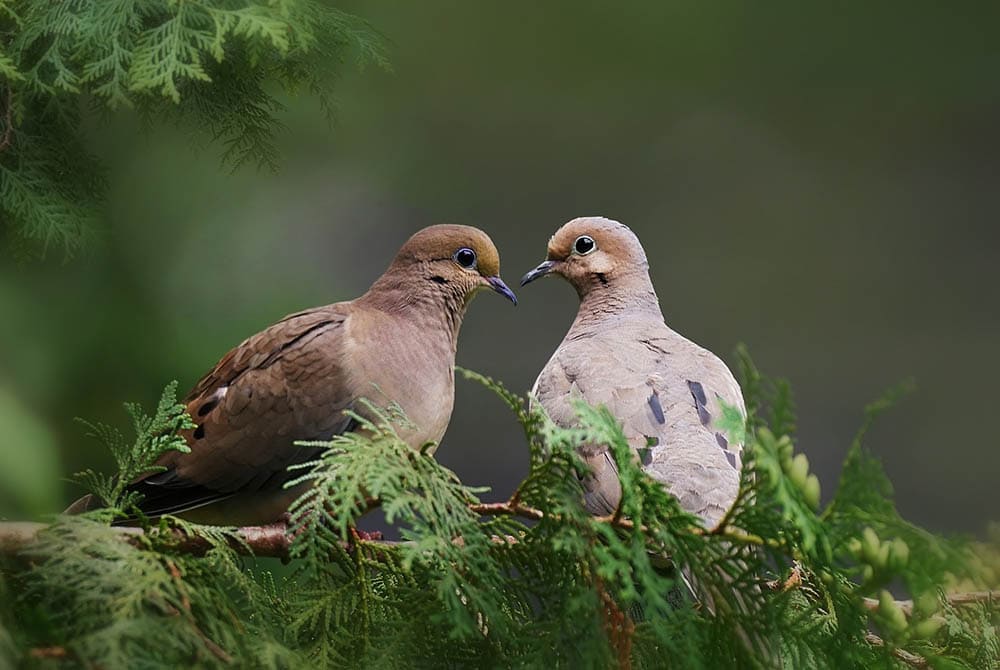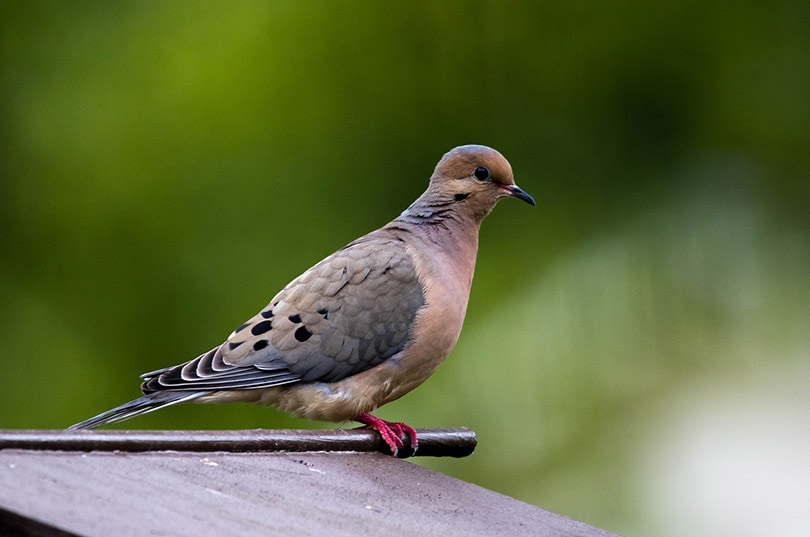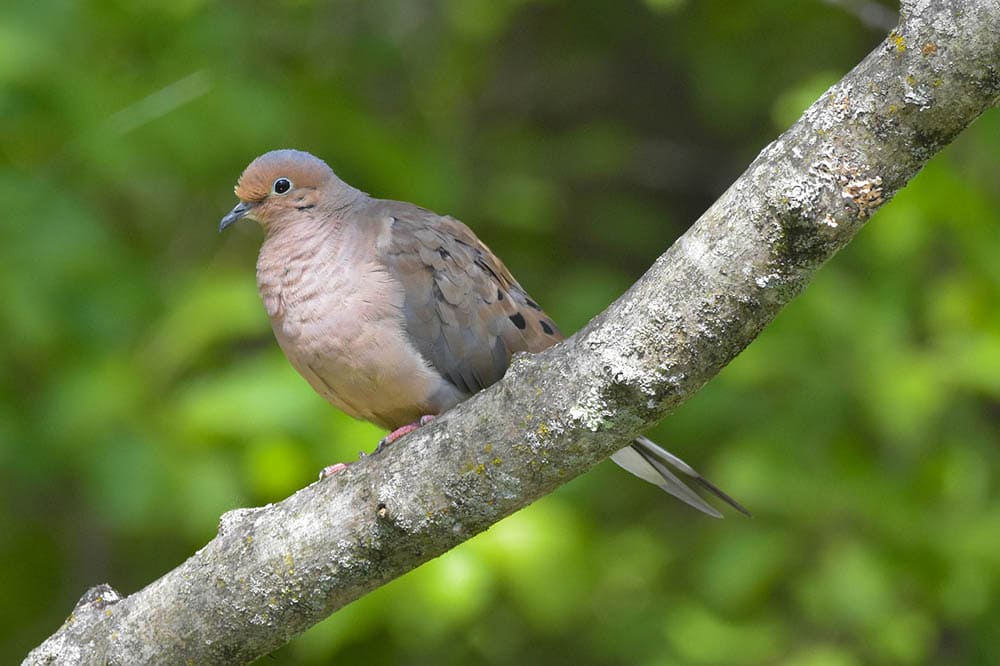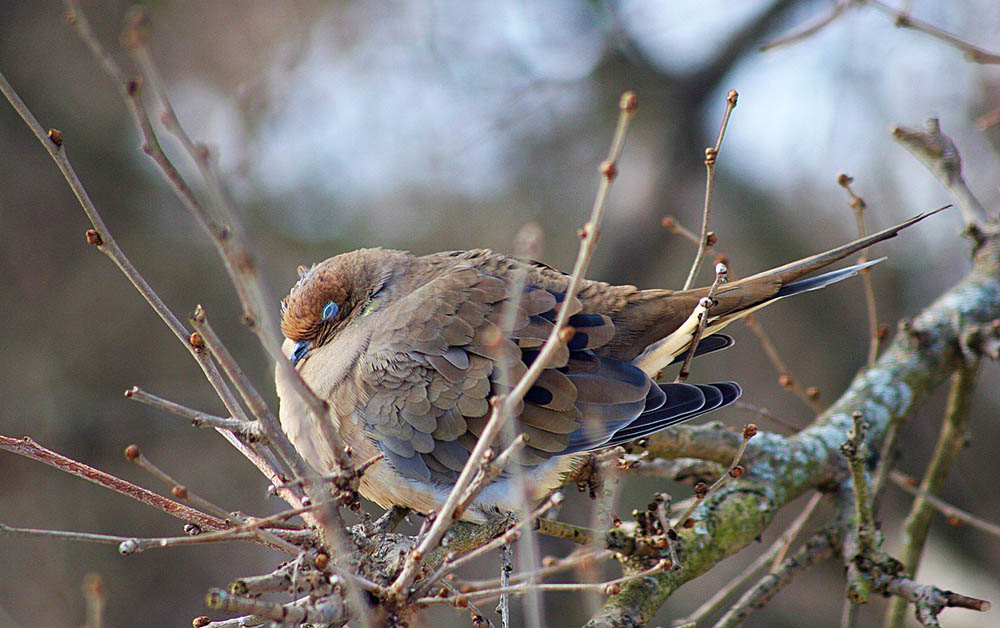Mourning Dove: Field Guide, Pictures, Habitat & Info
Last Updated on

The Mourning Dove is one of the most widespread avian species in the United States. Its call is unmistakable with its forlorn-sounding cooing. It’s known by several other names, such as the turtle dove or rain dove. It is part of the Columbidae family, which also includes pigeons. Wisconsin1 even made the Mourning Dove its symbol of peace in 1971.
Nevertheless, this species is a game bird, despite these contrary associations.

Quick Facts about the Mourning Dove
| Habitat: | Open woodlands, forest edges, grasslands |
| Diet: | Primarily seeds, grains, and fruits |
| Behavior: | Ground forager |
| Nesting: | Usually in trees and near human dwellings |
| Conservation: | Species of least concern |
| Scientific name: | Zenaida macroura |
| Lifespan: | 1.5 years on average |
Mourning Dove General Description
The plumage of the Mourning Dove varies from cream to tan with black spots that give the bird excellent camouflage. Its body is plump compared to its smaller head. It’s a medium-sized bird, about as big as a robin. The sexes both look alike, with the female slightly smaller than the male—not unusual for monogamous birds that don’t rely on elaborate coloration to attract a mate.
The face of the Mourning Dove is expressive with large black eyes and a small gray bill. Its tail feathers and wings are relatively long with a wingspan just under 18 inches. There are five recognized subspecies with slight variations in habitat and body.

Mourning Dove Range, Habitat, Behavior, Diet & Nesting
Mourning Doves live up to the reputation that their name implies. They are attractive birds with a pleasing call. They usually exist in the background, not making a fuss to be noticed, in contrast to more demanding birds such as Blue Jays. They live peacefully, using their doleful cooing to mark their territories.
Range
The range of the Mourning Dove covers the entire lower 48 states into Southern Canada and Northern Mexico. It is often a year-round resident in these areas as long as the food is abundant. However, it will travel farther north into Canada during the breeding season. You’ll also see the dove in Central America and northern parts of South America. It even lives in Greenland and the United Kingdom.
Habitat
The adaptability of the Mourning Dove accounts for its stable population. The FWS estimates its numbers are currently at about 194 million birds in the United States alone.
The dove occupies many habitat types, from parks to pastureland to forests. It is surprisingly tolerant of humans and may even build its nest closer to people than one may expect with a wild bird.

Behavior
Despite its body shape, the Mourning Dove is remarkably fast and able to elude all but the fastest of avian predators. Doves have some unique behaviors that set them apart from other birds. For example, they produce milk from glands in their crops to feed their chicks.
They will also fake an injury to lure predators away from their young. This is a common strategy among wildlife, including White-Tailed Deer. It’s an excellent way to fool the predator while using their superior flight speed to their advantage.
Diet
The Mourning Dove’s diet consists of nearly all grains and seeds, with occasional fruits and insects. It prefers to forage on the ground instead of plucking berries from tree branches. They often feed in croplands where food is typically abundant. This habit can make larger groups of birds, or bevies, nuisances to some people.
Nesting
Mourning Doves are the best builders when it comes to nests. The structure in which they build them covers for their untidiness. They typically only lay two eggs per clutch, making the parental investment of both parents essential. They are excellent parents that transition their young from crop milk to seed well. The chicks spend a relatively long time with their parents compared to others that fledge in just a few weeks.

How to Find Mourning Doves: Birdwatching Tips
The excellent camouflage can make Mourning Doves a challenge to spot. However, their calls will soon give them away, with males perched on utility lines protecting their territories. The cooing sound belies the fact that it’s a defensive call. Unlike many species, the fearlessness of Mourning Doves can make it easier to find them in places where other birds would remain elusive.
What to Listen For
The call of the Mourning Dove is unmistakable, unlike the garbled tweets and whistles of warblers and sparrows. You’ll likely hear the bird before you spot it.
Doves have the same repertoire you hear with many birds. There are calls to attract a mate, the cooing of pairs, and alarm calls to warn their species and others of predators.
What to Look For
Mourning Doves are easier to spot when they have something to say. Perching and vocalizing males are conspicuous. Of course, their calls will point to where to look for them in the branches above you.
When to Look
Mourning Doves are diurnal or daytime birds. Like many species, they wake early and forage not long afterward. They are often quiet during the late morning and early afternoon before revving up their activity again. Being ground foragers, you’re most likely to see them feeding on the ground. Calling birds are usually up in the trees overlooking their territories.

Attracting Mourning Dove to Your Backyard: Tips & Tricks
It’s not hard to attract Mourning Doves to your yard. They tolerate people well, so you likely won’t deter them. The best way to make sure that they are regular visitors is to provide them with the things they need. We’ve discussed their diet, which consists mainly of grains and seeds. Provide them with food, and they will surely come. However, they’re more likely to visit a platform feeder, but seeds on the ground will also work.
- Cracked corn
- Safflowers
- White millet
- Milo seeds

Mourning Dove Conservation: Is This Bird Threatened?
Mourning Doves are anything but threatened. Their numbers have increased thanks to their adaptability. They also eat many of the seeds and grains that other birds may shun. That’s a good thing if you’re offering wild avian visitors a blend with some of the picky species tossing out the safflowers or other seeds. This bird’s future is likely secure.
The FWS has a management plan for this upland game bird. Its purpose is to maintain the Mourning Dove’s population and balance it with the recreational interests of hunters. The agency has identified three zones, the Eastern (EMU), Central (CMU), and Western (WMU) Management Units.
It’s worth noting that only 40 out of the lower 48 states permit dove hunting. Thus, the management strategies will vary with this species in these places. The Mourning Dove has the protection of the Migratory Bird Treaty Act of 1918.
•What is Arizona’s State Bird? How It Was Decided?

Conclusion
The Mourning Dove is an attractive bird worthy of the attention it has received. Its beauty and haunting calls make it a memorable addition to anyone’s birdwatching list. It’s a bird of dichotomies, both as a symbol of peace and a game species. However, that takes nothing away from the special qualities of this dove. It only adds to its complexity and the story it has to tell.
Featured Image Credit: MiniMe-70, Pixabay
Table of Contents
About the Author Chris Dinesen Rogers
Chris has been writing since 2009 on a variety of topics. Her motto with all of her writing is “science-based writing nurtured by education and critical thinking.” Chris specializes in science topics and has a special love for health and environmental topics, and animals of all shapes and sizes.
Related Articles:
How to Clean a Refractor Telescope: Step-by-Step Guide
How to Clean a Telescope Eyepiece: Step-by-Step Guide
How to Clean a Rifle Scope: 8 Expert Tips
Monocular vs Telescope: Differences Explained (With Pictures)
What Is a Monocular Used For? 8 Common Functions
How to Clean a Telescope Mirror: 8 Expert Tips
Brightfield vs Phase Contrast Microscopy: The Differences Explained
SkyCamHD Drone Review: Pros, Cons, FAQ, & Verdict
